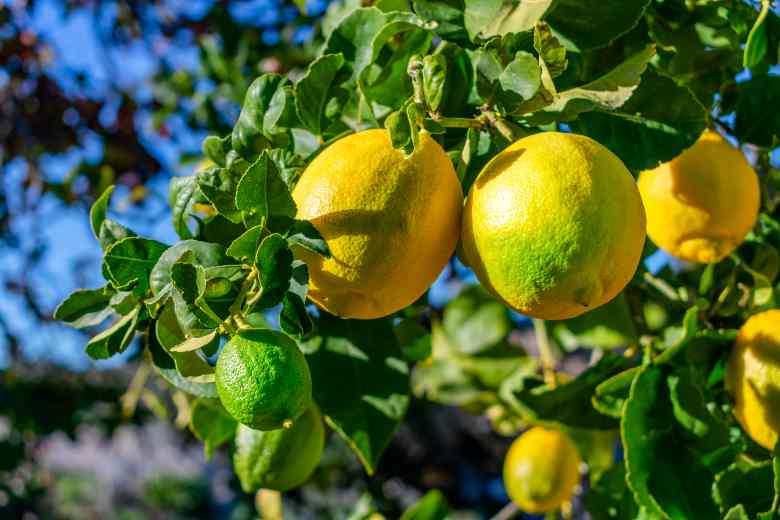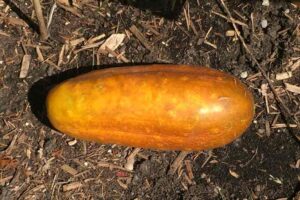
If you’ve ever wondered, “Does lemon and lime grow on the same tree?” you’re not alone. Lemons and limes are both popular citrus fruits used in cooking and beverages. However, many home gardeners are unsure if this tangy citrus can be cultivated together on a single tree.
The answer is simple – no, lemons and limes do not grow on the same tree. While closely related, lemons and limes are actually different citrus species that require their own individual trees for growing. Besides, they have different growing conditions and require different types of soil and climate in order to be successful.
Today, we will discuss the key differences between lemon trees and lime trees, from their taxonomy and appearance to cultivation needs. By the end, you will have a complete understanding of whether lemon and lime grow on the same tree” or if each fruit needs its own plant.
Taxonomy and Appearance of Both Tree
First, let’s start with taxonomy. Lemons (Citrus × lemon) are a hybrid citrus species that is thought to have originated from crossbreeding between sour orange and citron. Limes (Citrus aurantiifolia), on the other hand, are genetically distinct and classified as West Indian limes.
In terms of appearance, lemon trees and lime trees look quite similar when young, but there are some distinguishing features as they mature:
- Lemons have yellowish-green fruit that are larger and rounder than limes. Most common varieties grow 4-6 inches long.
- Limes have bright green fruit that are smaller and more elongated than lemons, usually 2-4 inches long.
- Leaves of lime trees tend to be thinner and darker green compared to the thicker, lighter green leaves of lemon trees.
- Lime tree bark is smoother than the rougher bark of mature lemon trees.
So, while closely related, lemons and limes are actually different citrus species that can be identified through their fruit and plant traits. This means they require separate trees for cultivation.
Planting Lemons vs. Limes
Now that we’ve established lemons and limes don’t share the same tree, let’s review the process of planting each type of citrus:
Lemons:

- Plant lemon trees in containers or directly in well-draining soil during late winter to early spring.
- Space trees 8-10 feet apart to allow for growth. Stake if necessary for support.
- Water deeply 1-2 times per week, allowing soil to dry slightly between.
- Fertilize monthly during spring and summer with citrus fertilizer.
Limes:

- Plant lime trees following the same timing and spacing guidelines as lemons.
- Limes prefer warmer climates and tolerate more shade than lemons. Plant in partial sun.
- Water and fertilize on the same schedule as lemons. Limes are also heavy feeders, so fertilize regularly.
- Lime trees are more susceptible to cold damage, so provide shelter from frost if necessary.
Note:
The planting steps are essentially the same for both species, with some minor differences in care needs based on each tree’s preferences. Proper spacing, fertilizing, and drainage are key to success.
Pruning and Training
Both lemon and lime trees will require pruning to develop a strong structure and maximize fruit production. Some basic pruning techniques include:
- Headbacks prune young trees to an open center branching pattern. Remove about 1/3 of the new growth.
- As trees mature, prune to maintain an open vase shape no taller than 8-10 feet.
- Remove broken, crowded, or diseased branches/twigs as needed.
- Practice light summer pruning to shape. Heavy pruning in winter may delay blooms.
For training, consider early methods like open center, espalier, or fan shaping against a sunny wall. This saves valuable space while regulating yields. Staking may also be needed in the early years. Proper pruning is important for the productivity and overall health of both lemon and lime trees long-term.
Pests and Diseases
Citrus trees can be susceptible to a variety of fungal diseases and insects. Some common issues for lemons and limes include:
- Mealybugs: Sap-sucking pests that secrete honeydew and spread sooty mold. Control with insecticidal soap.
- Scale: Armored scale insects clustered on branches. Treat with horticultural oil in dormancy.
- Citrus Canker: Fungal disease causing leaf drop and blemishes. Remove infected material and practice good sanitation.
- Root Rot: Fungal issue in overly wet soil. Improve drainage and do not overwater.
Scout trees regularly for signs of infestation. Integrated pest management, including natural and organic remedies, is key to protecting citrus without harming beneficial insects. Contact your extension office if issues persist.
When Do Lemons and Limes Bear Fruit?
With proper care, lemon and lime trees will become fruit-bearing around 2-3 years after planting. However, factors like climate and varietal selection can impact fruiting timelines:
# Lemons: Expect first harvest 2-4 years after planting. Trees mature and reach full production around 4-6 years.
# Limes: Lime trees often fruit earlier, within the first 1-3 years. However, heavy crops may not occur until 3-5 years of age.
# Dwarf varieties may fruit sooner but yield less overall. Standard sizes take longer to fruit but produce higher quantities.
# Fruit often forms on new spring growth, so pruning must be limited in winter to encourage blooms the following spring.
Differences in Growing and Care
While lemons and limes have many similarities, there are a few notable differences in their preferred growing conditions and needs:
- Temperature: Limes favor warmer temps above 55°F and tolerate more shade. Lemons need full sun and prefer 60-75°F.
- Chilling hours: Lemons require winter chilling to set fruit buds, but limes do not need the cold and may drop leaves/fruit if chilled.
- Water: Limes are more drought tolerant, but both prefer consistent moisture, without drying out completely.
- Fertility: Limes are heavy feeders and need frequent fertilizing, especially nitrogen. Lemons are also heavy feeders when flowering/fruiting.
- Cold hardiness: While citrus is generally cold sensitive, limes are less hardy and damaged below 32°F. Lemons can withstand light frosts.
Therefore, limes thrive better in tropical to subtropical zones 9-11, while lemons succeed in a broader range of zones 8-10. Microclimates can also impact individual trees.
The Advantages and Disadvantages
To conclude, here is a summary of the pros and cons of growing lemons versus limes:
Lemons:
- Higher cold tolerance for more climates
- Generally larger, easier-to-handle fruit
- More flavor variety in cultivars available
- Flowers/fruitless susceptible to damage
Limes:
- Faster fruiting within 1-3 years
- More compact size fits smaller spaces
- Thrives in warmer climates where lemons struggle
- Higher disease resistance
- The exotic flavor is great for beverages/seafood
Conclusion
Overall, both lemons and limes are rewarding citrus to grow at home. Their versatility and unique flavors make either tree a valuable addition. Consider climate and preference to decide which species is best for your needs. Proper site, soil prep, and care will lead to bountiful harvests year after year.
Moreover, the key advantages and disadvantages of each citrus made it clear that lemons and limes have preferences suited to different climates and spaces.
To directly answer the question – no, lemons and limes do not grow on the same tree. While related, they are individual species that require separate plants for optimal growth. Understanding their unique profiles is key to successful home citrus gardening.





